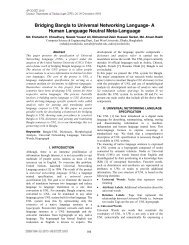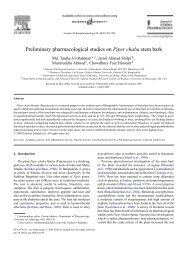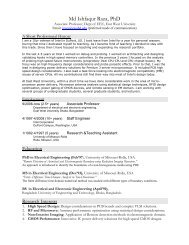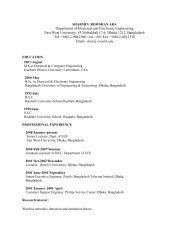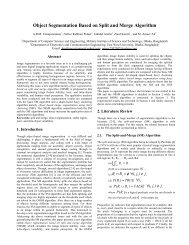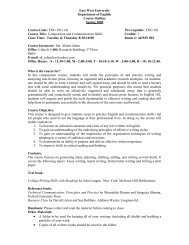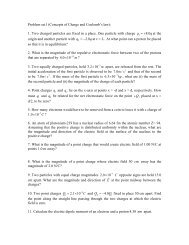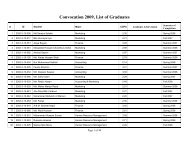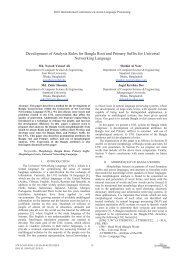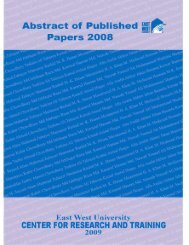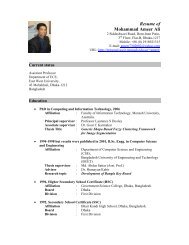Robust Object Segmentation using Split and Merge - East West ...
Robust Object Segmentation using Split and Merge - East West ...
Robust Object Segmentation using Split and Merge - East West ...
You also want an ePaper? Increase the reach of your titles
YUMPU automatically turns print PDFs into web optimized ePapers that Google loves.
(c)(d)Figure 8: (a) Original skeleton image, (b) Referenceimage of (a), (c)-(d) <strong>Segmentation</strong> results of the OSF<strong>and</strong> the proposed ROSSM algorithm respectively.Table 1: Statistics of qualitative performance of the OSF<strong>and</strong> the ROSSM algorithmsNomenclaturesOSFROSSMNo ofimagesNo ofimagesCorrectlySegmentedPartiallycorrectlysegmentedWronglysegmentedPercentageout of 211imagesPercentageout of 211images76 36.02% 152 72.04%62 29.38% 28 13.27%73 34.60% 31 14.69%To assess the robustness of the proposed ROSSMalgorithm, the experiments were conducted for 211different images having different objects containingdifferent shapes, sizes, orientations <strong>and</strong> features. Theexperimental results are shown in Table 1 where the OSFalgorithm produced correct segmentation results for 76images out of 211 images <strong>and</strong> hence the percentage ofsuccessfully segmenting images is 36.02% while theROSSM algorithm segments 152 images accurately with asuccess rate of 72.04%. The number of images for partiallycorrected <strong>and</strong> wrongly segmentation results for the OSF are62 <strong>and</strong> 73 respectively <strong>and</strong> for ROSSM algorithm for 28<strong>and</strong> 31 respectively. So, from this analysis, it can beconcluded that the ROSSM algorithm performs much betterin image segmentation than that of SM algorithm as well asthe OSF algorithm.6. ConclusionsThe <strong>Split</strong> <strong>and</strong> merge (SM) algorithm is well-knownalgorithm in digital image processing due to its simplicity,effectiveness, unsupervision <strong>and</strong> relative cost minimization,however, it is unable to achieve global optimum. Theproposed robust object segmentation based on split <strong>and</strong>merge (ROSSM) considers region stability as the key issuefor splitting while the region stability, region variances, <strong>and</strong>human perception as key issues for multi stage merging. Inthe ROSSM algorithm, the thresholds used for merging arecalculated dynamically based on inter-<strong>and</strong> intra-variancesof regions. As a consequence, the ROSSM algorithm is ableto segment all type objects in an image. The experimentalresults have shown that the ROSSM algorithm hasoutperformed the SM algorithm <strong>and</strong> a shape-based fuzzyclustering algorithm namely object based imagesegmentation <strong>using</strong> fuzzy clustering (OSF). This increasesthe application area of the SM algorithm where thesegmentation is critical. The main problem of the proposedROSSM algorithm is that it is unable to segment similar<strong>and</strong> connected objects well due to considering pixelintensity while they may be identified as different objectsconsidering the spatial location <strong>and</strong> also if multipleattributes were considered the objects could be classifiedmore accurately. In the splitting stage a region is dividedinto four almost equal sub-regions if the threshold valuepermits. This hard partitioning splits the image region intonumerous unwanted sub-regions which need to rejoin(merge) in the merging stage that requires noticeable timefor merging. An efficient soft clustering which can dividethe base region into stable <strong>and</strong> an optimal numbers ofregions instead of simply dividing it into four regionswould be a further development.Reference[1] M. Ameer Ali, Laurence S Dooley <strong>and</strong> Gour CKarmakar, <strong>Object</strong> based Image <strong>Segmentation</strong> UsingFuzzy Clustering, ICASSP 2006.[2] K. Haris, et al., Hybrid Image <strong>Segmentation</strong> UsingWatersheds <strong>and</strong> Fast Region Merging, IEEETransactions on Image Processing, Vol. 7 (12),pp.1684–1699, 1998.[3] D. Chaudhuri, B.B. Chaudhuri <strong>and</strong> C.A. Murthy, ANew <strong>Split</strong>–<strong>and</strong>-<strong>Merge</strong> Clustering Technique, PatternRecognition Letters, Vol. 13, pp. 399-409, 1998.[4] T. Pavlidis, Structural Pattern Recognition, SpringerVerlag, New York: Berlin Heidelberg, 1977.[5] J.F. Canny, A computational approach to edgedetection, IEEE Transaction Pattern Analysis <strong>and</strong>Machine Intelligence, Vol. 8 (6), pp. 679–698, 1986.[6] R. Ronfard, Region-based strategies for activecontour models, International Journal of ComputerVision, Vol. 13(2), pp. 229–251, 1994.[7] G.M. Hunter, K.S. Steiglitz, Operations on ImagesUsing Quad-Tree, IEEE Transaction PatternAnalysis <strong>and</strong> Machine Intelligence, Vol. 1 (2), pp.145–153, 1979.[8] C. Revol, M. Jourlin, A new minimum varianceregion growing algorithm for image segmentation,Pattern Recognition Letters, Vol. 18, pp. 249–258,1997.[9] S.L. Horowitz, T. Pavlidis, Picture segmentation by adirected split-<strong>and</strong>-merge procedure, Proceedings ofthe 2nd International Joint Conference on PatternRecognition, pp. 424–433, 1974.[10] T. Brox, D. Firin <strong>and</strong> H. N. Peter, Multistage regionmerging for image segmentation, 22 nd Symposiumon Information theory in to Benelux, pp. 189-196,Enschede, 2001.



